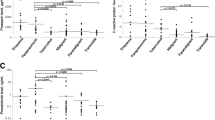Abstract
The determination of pleural fluid triglycerides (PF-TRIG) is useful in the diagnosis of chylothorax, but its diagnostic value for other causes of pleural effusions is unknown. The aim of this study was to evaluate the usefulness of PF-TRIG in the diagnosis of other pleural effusions and investigate the origin of their increase in these fluids. We studied 390 pleural effusions (75 tuberculous, 107 neoplastic, 39 parapneumonic, 30 miscellaneous, 42 idiopathic, and 97 transudates). The correlation was analyzed with the PF-TRIG values as the dependent variable and serum triglycerides (S-TRIG) and the pleural fluid/serum protein ratio (PF/S PROT ratio) as independent variables. The PF-TRIG was significantly higher in exudates. The sensitivity of PF-TRIG for identifying exudates was 84.3%, specificity 61.9%. The correlation between PF-TRIG and S-TRIG was significant in the exudates and in the total pleural effusions. There was a significant correlation between PF-TRIG and S-TRIG and capillary permeability, which worsened when looking at the transudates and exudates separately. No correlations were found between the PF-TRIG and the number of red cells and white cells in any of the groups. Except for diagnosing a chylothorax, the determination of triglycerides in pleural fluid does not appear to be justified. The cause of the increase in PF-TRIG in exudates could not be established because the correlations obtained were insufficient to be able to predict PF-TRIG values from their serum values and the measurement of capillary permeability.



Similar content being viewed by others
References
Collins TR, Sahn SA (1987) Thoracentesis: complications, patient experience and diagnostic value. Chest 91:817–822
Sahn SA (1987) Pleural fluid analysis: narrowing the differential diagnosis. Semin Respir Med 9:22–29
Sahn SA (1988) The pleura. State of the art. Am Rev Respir Dis 138:184–234
Gopi A, Madhavan SM, Sharma SK, Sahn SA (2007) Diagnosis and treatment of tuberculous pleural effusion in 2006. Chest 131:880–889
Valdés L, Álvarez D, San José E, Juanatey JR, Pose A, Valle JM, Salgueiro M, Suarez JR (1995) Value of adenosine deaminase in the diagnosis of tuberculous pleural effusions in young patients in a region of high prevalence of tuberculosis. Thorax 50:593–594
Valdés L, Álvarez D, Valle JM, Pose A, San José E (1996) The etiology of pleural effusions in an area with high incidence of tuberculosis. Chest 109:158–162
Hamm H, Pfalzer B, Fabel H (1991) Lipoprotein analysis in a chyliform pleural effusion: implications for pathogenesis and diagnosis. Respiration 58:294–300
Valdés L, Pose A, Suárez J, Gonzalez-Juanatey JR, Sarandeses A, San José E, Alvarez Dobaña JM, Salgueiro M, Rodríguez Suárez JR (1991) Cholesterol: a useful parameter for distinguishing between pleural exudates and transudates. Chest 99:1097–1102
Costa M, Quiroga T, Cruz E (1995) Measurement of pleural fluid cholesterol and lactate dehydrogenase. A simple and accurate set of indicators for separating exudates from transudates. Chest 108:1260–1263
Valdés L, Pose A, San José E, Suarez J, Penela P, Valle JM, Alvarez D (1998) Diagnostic value of cholesterol in pleural fluids. Eur J Intern Med 9:157–164
Staats BA, Ellefson RD, Budahn LL, Dines DE, Prakash UB, Offord K (1980) The lipoprotein profile of chylous and nonchylous pleural effusions. Mayo Clin Proc 55:700–704
Sahn SA, Heffner JE (2003) Pleural fluid analysis. In: Light RW, Lee YCG (eds) Textbook of pleural fluids. Arnold, London, pp 191–209
Mahley RW, Weisgraber KW, Farese RV Jr (1998) Disorders of lipid metabolism. In: Williams RH (ed) Williams textbook of endocrinology. WB Saunders, Philadelphia, pp 1099–1119
Meisel S, Shamiss A, Thaler M, Nussinovitch N, Rosenthal T (1990) Pleural fluid to serum bilirubin concentration ratio for the separation of transudates from exudates. Chest 98:141–144
Roth BJ, O’Meara TF, Cragum WH (1990) The serum-effusion albumin gradient in the evaluation of pleural effusions. Chest 98:546–549
Heffner JE, Brown LK, Barbieri C (1997) Diagnostic value of tests that discriminate between exudative and transudative pleural effusions. Chest 111:970–979
Romero S, Candela A, Martin C, Hernández L, Trigo C, Gil J (1993) Evaluation of different criteria for the separation of pleural transudates from exudates. Chest 104:399–404
Burgess L, Maritz FJ, Taljaard JJF (1995) Comparative analysis of the biochemical parameters used to distinguish between pleural transudates and exudates. Chest 107:1604–1609
Antony VB, Holm KA (1995) Testing the waters. Differentiating transudates from exudates. Chest 108:1191–1192
Maldonado F, Hawkins FJ, Daniels CE, Doerr CH, Decker PA, Ryu JH (2009) Pleural fluid characteristics of chylothorax. Mayo Clin Proc 84:129–133
Sahn SA (1995) Diagnostic value of pleural fluid analysis. Semin Respir Crit Care Med 6:269–278
Vaz MA, Teixeira LR, Vargas FS, Carmo AO, Antonangelo L, Onishi R, Light RW (2001) Relationship between pleural fluid and serum cholesterol levels. Chest 119:204–210
Valdés L, San-José E, Estévez JC, González-Barcala FJ, Álvarez-Dobaño JM, Golpe A, Valle JM, Penela P, Vizcaíno L, Pose A (2010) Cholesterol in pleural exudates depends mainly on increased capillary permeability. Transl Res 155:178–184
Hillerdal G (2003) Effusions from lymphatic disruptions. In: Light RW, Lee YCG (eds) Textbook of pleural diseases. Arnold, London, pp 362–369
Disclosure
The authors have no conflicts of interest or financial ties to disclose.
Author information
Authors and Affiliations
Corresponding author
Rights and permissions
About this article
Cite this article
Valdés, L., San José, M.E., Pose, A. et al. Usefulness of Triglyceride Levels in Pleural Fluid. Lung 188, 483–489 (2010). https://doi.org/10.1007/s00408-010-9261-4
Received:
Accepted:
Published:
Issue Date:
DOI: https://doi.org/10.1007/s00408-010-9261-4




